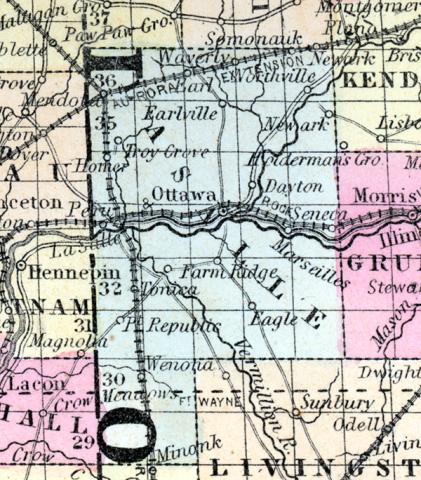LA SALLE, p-v.. La Salle co., Ill., 133 N. N. E. Springfield, 788 W. Situated in a prairie adjoining Peoria lake, and contains over 100 dwellings. (Haskell's Complete Descriptive and Statistical Gazetteer of the the United States...,1840)
LA SALLE The city of La Salle is situated in the county of the same name, at the head of navigation on the Illinois river, where the Illinois Central intersects with the Rock Island railroad, 16 miles from Ottawa, the county seat, 114 from Springfield and 98 west-south-west from Chicago. La Salle is one of the most important commercial and mining points on the river, which is navigable to here for steamboats of considerable size. The number of arrivals during the year 1857 were 327, bringing cargoes of the various kinds of merchandise, while the exports were 230,000 bushels of wheat, 172,000 bushels of corn, 75,000 bushels of oats, 16,200 hogs, 11,100 barrels of salted provisions, 157,000 bushels of potatoes, 600 tons of lime and 260,000 tons of coal. The city abounds in this latter staple; eight mines being now in operation, in which are employed about 1,000 men, and yeilding from 100 to 400 tons daily.
The La Salle Coal Mining Basin, in which is operating the Little Rock Coal Mining Co., forms the northern boundary of the coal fields of the state, is intersected by the railroads above mentioned, and is the terminus of the Illinois and Michigan canal, which unites with the Illinois river at this point. The coal procured at these mines are of good quality and admirably adapted to manufacturing purposes, and the cheap rate at which it is afforded place it in competition with that of eastern mines. The immense quantities to be found here, and the increasing demand for it, has also rendered necessary a large increase of capital and labor, which is estimated at 40 per cent, per annum. The river at La Salle is 900 feet in width, and is spanned by a substantial bridge, having 20 arches of 45 feet span each, supported by massive stone pillars and abutments. The cars pass over this bridge in their transits east and west. Manufacturing is carried on here to a great extent, and embracing utmost all branches; among which are two large breweries, making 12,000 barrels of beer annually, five extensive brick yards, four lime kilns, a steam flouring mill, having six run of stones, turning out 2,400 barrels of flour weekly, a planing mill, a large foundry and machine shop, a saleratus factory, a rectifying distillery, a soap and candle factory, etc., etc.
In the summer of 1857 a company was organized for the purpose of manufacturing flint glass, and buildings erected in the city. These buildings are three in number, and make an imposing appearance, the largest being 56 by 89 feet, is to be used for melting and blowing; the next is 30 by 64, and is designed to be used as a cutting shop, the machinery to be driven by a six horse power engine; the other is 20 by 100 feet, and will be used to manufacture their crucibles in, etc. The mechanical department is under the direction of Jean Pierre Colne, who was fifteen years assistant manager in the largest glass manufactory in France, that of Boccarat, in which was employed about 1,400 hands.
The healthy situation and other natural advantages of La Salle, its easy communication south and west by either railroad or river, and the great abundance and low price of coal and sand of a superior quality, will tend greatly to insure the success of this new enterprise in our state.
In educational advantages this city is not behind others of her size, having a collegiate seminary belonging to the Catholics, and a Protestant seminary, this latter costing about $11,000, and is capable of accommodating 350 students; besides these there are five district schools, which are well attended. There are five churches, viz.: One Episcopalian, one Baptist, one Roman Catholic, one Congregationalist and one Methodist, all of which are fine buildings, adding much to the beauty of the city. There are also several banking establishments, two newspaper offices having weekly issues. The Hardy House, the only hotel of note, is a large and commodious building, occupying a central position. The city is built on a bluff rising from the river, affording an excellent view of great beauty, extending as far as Peru. Taking into consideration the vast amount of mineral wealth which underlies the city and surrounding district, the facilities for transportation to and from other points, and the healthiness of the climate, this may justly be considered one of the most prominent points of interest in the west
La Salle is separated from Peru only by an imaginary line, which, were it done away with, and the two cities united in one common interest, would tend greatly to the advancement of both, making one of the first cities of the west—one in name and one in interest. We doubt not such a movement would meet with general favor from the citizens of both places. Population, 4,400. J.H. McFarron, Postmaster. (Hawes' Illinois State Gazetteer...,1859)

